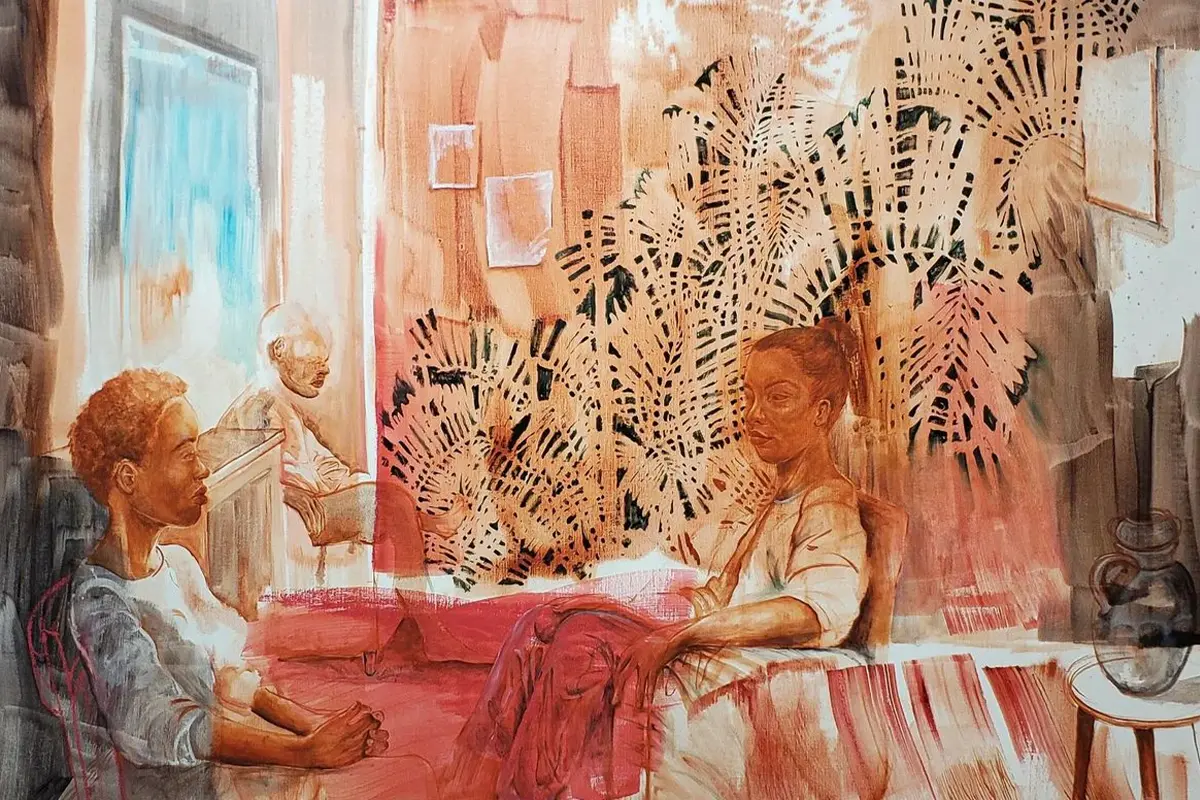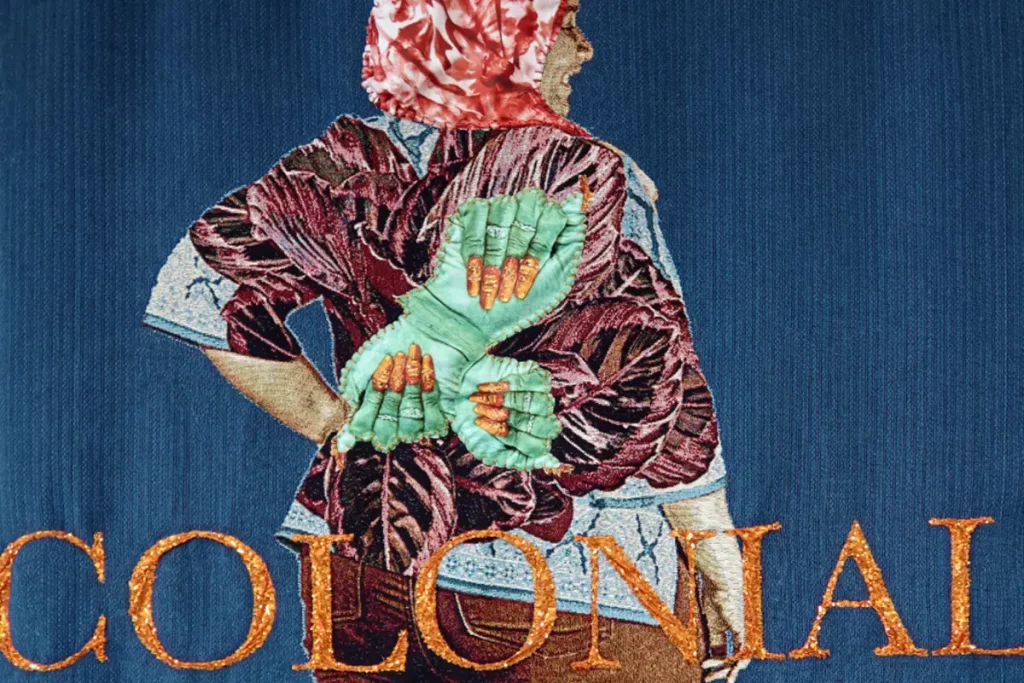With a multidisciplinary exhibition 1-54 and Caryl Ivrisse Crochemar aim to portray the cultural, ethnic, and artistic diversity of the Caribbean archipelago
1-54 presents Caribbean art exhibition Sparkling Islands
From May 18 to May 21, 2023, 1-54 Contemporary African Art Fair will hold its ninth New York edition, with a total of twenty-six galleries hailing from across Africa, Europe, Asia and the United States. The fair will present the work of over eighty artists from Africa and its diaspora in a grand modern venue located in Manhattanville Factory District in West Harlem.
Part of the fair this year will be Sparkling Islands: Another Postcard of the Caribbean, an exhibition curated by Caryl Ivrisse Crochemar & [creative renegades society], which will showcase a new generation of contemporary artists from the Caribbean archipelago and its diaspora. On view from May 11 to May 21, the exhibition is conceived as a series of open-ended questions that invite viewers to push beyond superficial portrayals of the archipelago as a sunny tourist destination and reflect the diversity of cultures informing contemporary Caribbean art.
A project by Caryl Ivrisse Crochemar for 1-54
Sparkling Islands: Another Postcard of the Caribbean is a collective exhibition born from the initiative of Caryl Ivrisse Crochemar, founder of the Espace d’art contemporain 14N61W, an art gallery located in Fort-de-France, on the island of Martinique. From its opening in 2013, the gallery has been focusing on contemporary art in the Caribbean and around the world, exploring various media and reflecting on the impact and interactions of such avant-garde artworks, both regionally and worldwide.
While taking part in international art fairs in New York and London, Caryl realized that the Espace d’art contemporain 14N61W was the only existing Caribbean art gallery and that most of the Caribbean artists lived and worked abroad: «Last year at 1-54 New York edition we discussed about doing a focus on artists of African descent, whether they were based in the United States, in the Caribbean or elsewhere, in order to strengthen their tides with the African diaspora in the art scene, because they still seemed to be worlds apart, even though they are actually linked. This is not something that comes naturally for both communities, but the integration of our gallery in 1-54 for so many years aroused the interest of many Caribbean artists towards the fair».
Sparkling Islands: Another Postcard of the Caribbean at 1-54
When thinking about the Caribbean, most people – whether they have ever visited the archipelago or not – picture sunny beaches and crystal-clear waters. Sparkling Islands: Another Postcard of the Caribbean does not wish to contradict such image, but to expand it: «There is also the historical part, the broken history of the Caribbean in general, the pre-Columbian history, the proto-colonial history, the post-colonial history and the present development».
In such a variety of themes there was «a multitude of possible messages», but the curators preferred to conceive the exhibition in the «simplest way possible, as a series of snapshots, just like the postcards you send to your friends from a holiday vacation». Still, these postcards tell a different story from the mainstream narration of the Caribbean archipelago: «We attract the visitors’ attention towards something that they would probably pass by if they went to the Caribbean. It is 2023 and we are at a crossroads of many things in culture, identity, gender, and we need to experience this diversity as creatively as we can».
An Exhibition without a Red Thread: Exploring the Vast Environment of Caribbean Art and Culture
The artworks featured in the exhibition neither follow any particular red thread nor aim to offer an overall insight of Caribbean art and culture: «This would have been impossible; the exhibition is just an open door to a much vaster environment. The Caribbean is neither compact nor homogeneous. Due to its history, which we may call “a discontinuous continuity”, the archipelago is a melting pot. It is not to be forgotten that the Caribbean were the first point of entry into America for the West, both Europe and Africa. So, when you pull one thread, you just end up pulling many, such as identity, diversity, cultural mixing, colonialism, post-colonialism, future. In the end, the only possible red thread is the public, who will be able to take all the information received from the exhibition in the direction they choose».
Thirteen artists from the Caribbean diaspora displayed at 1-54
Sparkling Islands: Another Postcard of the Caribbean features a variety of works produced with different media and materials by thirteen artists of Caribbean origin, all scattered throughout the world: «Most of them I know personally, some are friends, with some of them I have already collaborated with. When I was asked to curate the show, I took it as a challenge because I had only one month to prepare it, but I did not choose which artist to include on a pure availability basis – I wanted them to be personally involved, to share our vision of a platform where different communities of African descent can exchange. Also, I always try to balance the male and female presence as much as possible».
The fact that what can be generally defined as ‘Caribbean art’ is represented in the exhibition by artists often mixed-race and living abroad should not come as a surprise: «I personally do not even like the label “Caribbean art”, because it involves so many practices, so many different backgrounds and histories. Nowadays, Caribbean art is not produced in the Caribbean because of a lot of reasons, such as access to resources, the cost of import and taxes for materials. Colonialism even stopped the interaction within and between the islands: for example, we do not have a transport system that connects the archipelago. So, it is easier for artists to work in urban centers either in the United States or in Europe, but they weave into their practices their backgrounds and communities».
Five female artists Exploring Identity, History, and Social Issues through Art
Alberta Whittle is Barbadian-Scottish and works across media: film, sculpture, print, installation and performance. Her work is concerned with the legacies of colonialism, slavery and black oppression, as well as environmental issues such as the climate crisis.
Deborah Jack is a Caribbean visual artist and poet. Raised on the island of Saint Martin, she studied and now works in the United States. Her visual art is conceptual and interdisciplinary: she employs installation, photography and film to explore themes related to the African diaspora, to memory and time.
Anina Major comes from the Bahamas but is now based in the United States. She uses ceramics to investigate the relationship between self and place as a site of negotiation, producing artworks often pervaded by a sense of nostalgia.
Johanna Mirabel has Martinique, Guyanese, Guadalupe and French origins. Born in France, she is now represented by the Italian Luce Gallery. Her large-scale paintings shift between abstraction, expressionism and realism, focusing on the concept of memory and combining personal memories with historical and cultural heritage – all elements that contributed to the definition of the artist’s personal identity.
April Bey comes from the Bahamas but is based in Los Angeles. She produces mixed media works engaged with contemporary African feminism.
Exploring Multiculturalism and Identity: Caribbean Artists Redefining Contemporary Art for 1-54
Jean-Ulrick Désert was born in Haiti, studied in the United States and now lives and works in Berlin. His art is multidisciplinary and conceptual, often provocative. He aims at giving voice to all the «silences» of contemporary society, whether they are immigrants, black people, LGTBQ communities.
Remy Jungerman is Surinamese-Dutch and lives in Amsterdam. He explores the intersection of pattern and symbol in Surinamese Maroon culture and Twentieth century Modernism, combining Maroon textiles, kaolin clay used in several religious traditions and nails from the Nkisi Nkondi power sculpture with materials and imagery deriving from more established art traditions.
Zak Ové is British-Trinidad, lives between the two countries and ranges between sculpture, film and photography. His artworks show an interest in diasporic and African history, which he explores through Trinidadian carnival and filters through his own personal and cultural upbringing, with a black Trinidadian father and a white Irish mother.
Adler Guerrier was born in Haiti, but now works in Miami. He uses the form of collage – which he regards as a democratizing technique – to subvert space and time in constructions of race, ethnicity, class and culture.
Exploring Mythology, Diaspora and Gender: Caribbean Artists Redefining Artistic Boundaries
Yoan Sorin is from Martinique and France. His artwork is based on exploded mythologies that the artist updates through drawings, installations, paintings and performances, which reference African American history, hip hop, branding, streetwear and the histories of art and sports.
Nyugen E. Smith is a Caribbean-American interdisciplinary artist based in New Jersey, who employs performance, found object sculpture, mixed media drawing, painting, video, photo and writing to explore historical and present-day conditions of Black African descendants in the diaspora.
Leasho Johnson is a Jamaican multimedia artist whose works exploit sexually explicit imagery and culturally specific materials to challenge existing constructs of masculinity, reflecting on how personal, ancestral and communal narratives surrounding sexuality and gender identity get shaped by the legacy of empire and colonialism.
Roland Dorcély is the only non-living artist featured in the exhibition. He was a Haitian avant-garde painter and poet, whose works are now displayed at the Paris’ Museum of Modern Art and in New York City’s MoMA.
1-54 New York
Sparkling Islands: Another Postcard of the Caribbean is a collective exhibition of Caribbean art that will be part of the 1-54 Contemporary African Art Fair 2023 New York edition. On view from May 11 to May 21 in Manhattanville Factory District in West Harlem (439 W. 127th St), the exhibition will feature multidisciplinary artworks produced by thirteen artists of the Caribbean diaspora.




















